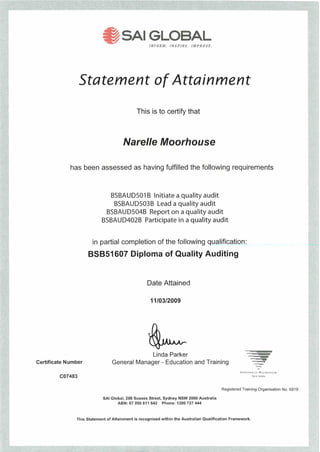1 of 1
Download to read offline

Ad
Recommended
Quality Audits
Quality Audits Vasanth Kumar
Ã˝
The document provides details on conducting quality audits, including:
1) An overview of audit preparation such as developing an audit plan, selecting auditors, and preparing documentation for review.
2) Guidelines for performing the audit such as conducting an opening meeting, touring the site, reviewing documentation, and holding a daily wrap-up meeting.
3) Details on audit techniques including asking questions, classifying observations, and conducting a close-out meeting to discuss audit findings.QMS Audit (updated)
QMS Audit (updated)Pat Kilbane
Ã˝
This document provides an overview of auditing a Quality Management System (QMS) according to ISO 17025. It defines a quality audit as a systematic and documented process to evaluate if agreed procedures and criteria are being followed. Audits are conducted to ensure compliance, identify improvements, and provide confidence in the effectiveness of the QMS. The auditor should be trained and independent, using checklists to audit elements like quality manuals, procedures, records and evidence. Non-compliances are documented for corrective action, with follow-up to ensure issues are addressed. Effective auditing involves planning, conducting the audit, reporting findings, and following up on issues.Fundamentals of Auditing PTC
Fundamentals of Auditing PTCcarroll sams
Ã˝
The document provides an overview of quality auditing and the audit process. It discusses the four phases of an audit: 1) initiation and preparation, 2) on-site evaluation, 3) reporting, and 4) closure. The preparation phase involves developing an audit plan, checklist, contacting the auditee, and conducting a desk audit. The on-site phase consists of an opening meeting, tracing techniques to collect evidence, and briefing the auditee. The reporting phase includes an exit meeting and a formal written report. The closure phase tracks actions to address nonconformities.Practical auditing
Practical auditingIsidro Sid Calayag
Ã˝
This document provides an agenda for a training on practical auditing for internal quality auditors. It discusses key audit concepts like the PDCA cycle and process approach. It also covers important audit skills like interview techniques, note taking, report writing, and auditing difficult clauses. Common audit findings are presented along with tips for auditing undocumented processes and improving audit practices. The document concludes with an auditor code of ethics emphasizing integrity, objectivity, confidentiality and competence.Practical Auditing
Practical AuditingIsidro Sid Calayag
Ã˝
This document provides an overview of internal quality auditing techniques and common ISO 9001 requirements. It discusses using a process approach and PDCA cycle in audits. Interview skills like questioning techniques and taking notes are covered. Creating checklists and potential issues with "cheat sheets" are also summarized. The document reviews writing audit reports and addressing nonconformities. It identifies some of the toughest ISO 9001 clauses to audit and the most common nonconformities found in internal and registrar audits.Introduction to Internal Quality System Auditing
Introduction to Internal Quality System AuditingJeffStevens
Ã˝
This document provides guidance on conducting audits according to basic auditing assumptions and definitions. It outlines the responsibilities of auditors and auditees, as well as qualifications needed by auditors. Guidelines are provided for audit quality assurance, working papers, lead auditor responsibilities, interview tips, audit plans, reports, techniques for understanding quality management systems, auditor attributes, inquiry categories, interview considerations, principles of audit reporting, process requirements, and sampling. The document describes elements of a successful audit from planning through closure.GMAT Math Flashcards
GMAT Math FlashcardsGMAT Prep Now
Ã˝
The document describes GMAT Prep Now's quantitative reasoning flashcards, which cover various topics including arithmetic, algebra, geometry, and statistics. Users can access related video lessons by clicking links provided on the flashcard pages, though registration is required for full video access. The content is organized into multiple sections, with each section containing numerous flashcards for study purposes.Work Hacks : Body Language
Work Hacks : Body LanguageInterQuest Group
Ã˝
In our newest ∫›∫›fl£Share series, we'll be taking a look at various 'work hacks' that will make your working life that little bit easier every day. 